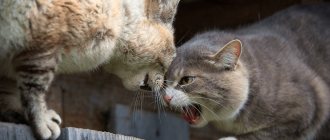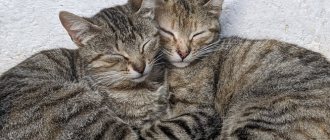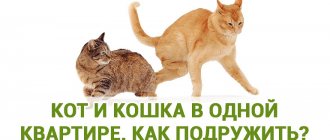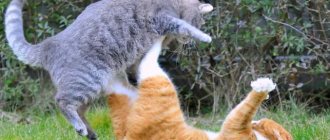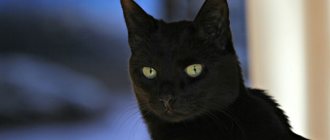How cats talk to people
Science has long been trying to study cats, but they are reluctant to participate in experiments and various types of research. Researchers prove that our four-legged furry creatures came to Europe from Egypt. But there is another version that the domestication of cats occurred in Nubia more than 3 thousand years ago from a North African cat. Only later did they appear in Egypt and Asia.
You can understand a cat's language by observing your pet.
Cats were respected and endowed with superpowers. The ancient Greeks, who brought cats into the country illegally, were immensely grateful to them for their fight against rodents and even made the cat a symbol of the Spartacus uprising. In Egypt, cats were used not only to fight mice and rats, to protect crops, they were trained to hunt birds, hares, and moles. The Egyptians elevated them to the rank of deity, whom they worshiped. Mummies of cats were found in the burials of ancient Egyptians along with the mummies of nobles.
Peaceful cat
In Rus', cats served in Orthodox churches, art galleries, palace chambers, and bazaars. The cost of the first cats brought to Russia was equal to the cost of an ox and amounted to 200 grams of silver. Cats are still in service in the Hermitage. Each of them has their own personal bowl, place to sleep, and veterinary documents.
Important! The only animal that is allowed to enter the temple freely is a cat.
People love their furry pets so much that they even decided to make March 1st World Cat Day. True, it has not been officially approved anywhere, but lovers of their fluffies all over the globe on this day show them all respect, honor and gratitude for their existence, for their fight against rodents.
Sign language: what does the tail, paws, ears, posture mean?
Cats do not speak human language; cat language causes confusion in humans. But if you try and observe our smaller brothers, their facial expressions and behavior, you can learn to understand cat sign language.
Aggression in cats can be caused not only by their dissatisfaction; perhaps they are worried about something, are alarmed, and seek protection from the owner. They cannot draw attention to themselves in any other way, it doesn’t work.
Note! If you look at a cat under a “microscope,” then its body language can say a lot.
The position of an animal's tail can also tell a story. For example, a peacefully resting cat begins to nervously move its tail from side to side when its owner approaches. This suggests that something is bothering him, he is alarmed, nervous. If only the very tip of the tail moves, it means that the anxiety is minor or the pet is falling asleep.
A tail raised to the top tells of the dominance of a given individual over others or shows the alertness of the animal. Sharp swings of the tail from side to side indicate extreme irritability of the pet, its dissatisfaction, and a warning of an attack. In this case, it is better to leave him alone until he calms down.
For your information! Animals can greet each other with their tail raised. A tail hanging down indicates that the pet is hungry, thirsty, or dissatisfied with something.
Cats attract the owner's attention with a soft touch of their paw pads when they are hungry, thirsty, or ask to be petted. They can hug the owner’s arms or legs, grab the edge of clothing, or climb up pants with their claws.
To attract attention, cats go to different lengths
Stomping all over their owner, their claws slightly extended, as if giving a massage, the fluffies succumb to the instinct associated with childhood, when they received their mother's milk by massaging her breasts. That is, there is recognition of a loved one, a feeling of security, safety.
The language of cats in the form of a raised paw tells of concentration, the desire to understand the unknown, caution, and a state of shock. Having dealt with the incomprehensible, the animal dies.
Facial language: smile or grin
The downward whiskers indicate that something is wrong with the kitten, perhaps he is not feeling well, he is dissatisfied with something, or irritated. Licking that is not related to food indicates nausea or thus shows concern or interest in something.
Their muzzle, like a human face, can express a serene mood, satisfaction, or vice versa, fear and aggression. A smile expresses a good mood, and a bared mouth warns of the threat of an attack.
A cat sitting with his tongue hanging out and his mouth slightly open means that he is focused on hunting for a mouse, or he is hot, or he was caught stealing from a table. It looks pretty funny, unless of course it is a disease.
Sad face with drooping mustache
What does attention to the ears mean?
A cat mood phrasebook can be compiled based on the position of the ears. Ears directed forward tell about the pet’s good mood, its peace, calmness, and readiness to make contact. Ears turned in different directions indicate that the animal is worried, does not know how to behave, and is showing interest in something or someone.
But ears pressed to the head or sticking out back warn of impending danger. The pet is alarmed, afraid of something, ready to attack at any moment. By twitching their ears, cats are trying to say that they are nervous, anxious or don’t like being scolded for their offense; they are not inclined to communicate at the moment.
Body poses
Unable to express their emotions in words, cats try to show it through their body postures. Approaching the owner, the fluffy ball shows its affection towards him by dancing its body. He presses himself to the legs, stands on his hind legs, rises and falls, showing his love in every possible way.
The stomach of any animal is the most vulnerable, least protected part of the body. If the cat lies down on its back, exposing its tummy for stroking, it means that it trusts the person immensely, feeling completely safe. He is sure that he will not be harmed or hurt.
Additional Information! If an attempt to stroke the animal’s tummy causes a protest, it means that the cat is simply scratching its back and is not waiting for affection from the outside.
Pose when the pet likes everything
Voice signals
How to understand a cat, what he is trying to say when he meows, can be determined by observing him from the side. By meowing, a cat can notify that it has gone to the litter box, is hungry, asks to be let out into the street or let into the house, simply in this way expresses its emotions. With a hiss, she warns of an attack, expressing her dissatisfaction, fear, and aggression.
Important! A cat finds her kittens to nurse by the vibrating sound they make immediately after birth. This habit of attracting attention when they are hungry continues into adulthood.
Cats purr loudly when demanding food and while eating it. The tonality of the rumbling differs in different cases. The hungry rumbling-meowing of a lost or abandoned kitten resembles the crying of a baby.
Loving mother and kitten
What does friction against the owners mean in cat language?
If a mustachioed pet rubs against the legs, arms or face of the owner, he expresses his declaration of love to him. By touching a person's lips with a wet nose, the animal seems to kiss him and express his gratitude.
There are now many videos on social media apps showing cats talking to their owners. The cat talks like a person, can respond to the inconvenience caused to him, there is a conversation between two cats sharing territory. All these videos can be viewed and are free to download. It turns out that getting them to talk is not as difficult as it seems. A cat can be made to learn a few words or phrases in human language.
If a cat rubs against its owner, it shows its love.
What does a cat want to say with a gentle purr?
Purring shows that the cat is good, comfortable, happy with everything, loves and is loved. But sometimes rumbling can express pain, nervousness, and fear. According to veterinarians, cats purr when they die when they are euthanized.
There is an opinion that the rumbling of an animal helps relieve stress and rejuvenates tissues. The frequency of 25-100 Hz, at which purring occurs, is used in many therapeutic devices in physiotherapy rooms. At a frequency of 25-50 Hz, bones grow together better, and at a frequency of 100 Hz, soft tissues and skin are healed.
What does a cat's screams mean?
When bringing a cat into the house, many expect only a joyful purr from it on their lap. But each animal has its own difficult character. When it has any desires or problems, it can express them with such a loud cry that can be heard several kilometers away.
A pet will not scream for no reason, there is always an explanation for this. Most often, the reason to shout is sex hormones, which begin to act with the onset of spring. The language of cats notifies the circle of his desire to have a cat.
Additional Information ! An unsatisfied cat may demand a cat up to 10 times a year. The cat gets excited every time he feels the female’s sexual secretion.
Failure to satisfy sexual needs negatively affects the physical and mental state of the animal. To satisfy their physiological needs, cats place marks in the apartment, try to escape outside, and howl heart-rendingly. With their screams they try to attract mating partners.
Redistribution of territory
A pet's cry may mean dissatisfaction with changes in his life. This could be moving to a new place of residence, the appearance of a new pet in the family or the loss of an old one, or a change of owner. The animal expresses its dissatisfaction with circumstances, stress from what is happening, and uncertainty about the future by screaming.
Pay attention to the ears
A cat's facial expressions are not very diverse: the pet can take on an independent appearance, show that it is dissatisfied or upset, but body language is more expressive.
A quivering tail, extended claws, or pinned ears can tell the owner much more.
If the cat:
- holds “ears on top of the head” (raised the skull vertically), which means the pet is feeling curious;
- spread his ears to the sides, slightly pressing them to the head, which means he is involving him in the game;
- curled up his ears and squinted his eyes, which means he was asking for food, affection;
- threw it back, widened his eyes, it means he’s angry, he’s warning;
- pressed to the skull, it means he is about to attack;
- pressed to the skull, twitching its tail, which means irritated;
- He lowered his ears to the bottom, which means he is sick, upset, guilty.
You need to pay no less attention to the tail, eyes, and body of the animal; every look and pose means a certain emotion.
Facial expressions
Facial expressions will help you understand the language of cats. Fluffies know all the expressions from birth. Half-closed eyes indicate peace; wide open eyes indicate preoccupation with something.
Dilated pupils mean that the animal is frightened by its surroundings. If the pet looks straight at you, then it challenges you. Squinted eyes have the same meaning.
Looking away is a sign of submission. Another way of speaking is through animal ears. If they are pressed, the owner is scared; if they are lowered to the sides, the owner is aggressive.
Forward-facing, boat-shaped ears indicate relaxation. When a furry predator nervously moves its ears, it expresses uncertainty or is irritated.
A sign of bliss is a closed or slightly open mouth. If the teeth are barely raised in a grin, then the pet wants to bite. The cat’s “grin” expresses interest in the smell. Otherwise, it is called “Flemin’s smile.”
Cats yawn when they are completely relaxed, and rapid licking of the lips signals confusion.
Can a cat understand a person?
How to make cats friends with each other in an apartment: examples of how to reconcile
Many cats, unlike dogs, live an independent life, coming into the house only for the purpose of sleeping in a safe place. Most existing cat breeds have been bred by breeders over the last hundred years. Until this time, selection aimed at identifying and consolidating special character traits had not been carried out.
For your information! Their understanding of a person is based on the benefit and comfort of their loved one.
If the inhabitants of the house are in a good mood, then the cat will get something tasty, they will caress it, stroke it, and sit it on their lap. If the owner is angry, upset, dissatisfied, he can yell at the pet, take it out on him, throw him out the door, and don’t even think about the treat. Therefore, the ability to understand a person’s mood and understand it is necessary for living comfortably together and for building relationships.
To understand a person, it is necessary, first of all, for the animal to perceive its owner as a companion. This perception is laid down in the kitten before it reaches eight weeks of age, when it has just begun to develop. The second stage of obedience and understanding of a person is to stimulate the baby to take the right action through praise and encouragement.
Education starts from childhood
Kittens raised in this way from early childhood, in adulthood, willingly make contact and communicate with people. They are able to recognize the owner by their steps, by their voice, understand sign language, feel the intonation of human speech, and can determine the mood of their companion by facial expressions and body posture.
Animals behave differently around strangers. They do not make contact with strangers, they are not interested in their emotions. To determine their reaction to a guest in an unclear situation, they rely on the emotions of their owner.
Untranslatable pun
Of course, there will always be cases when a pet’s behavior or the sounds it makes are so atypical that even a specialist cannot interpret and “translate” them. But this is not so bad: the unusual talkativeness of many tailed animals has already brought them to Internet fame. Videos with such cats sometimes receive millions of views. Let us recall the most striking examples.
After the cat Tikhon became famous online with his debut video, which has currently received almost 6.3 million views, his owners created an entire Youtube channel, on which the tailed cat’s monologues are periodically posted.
Tikhon's less famous brother is very convincing when he wants to get home.
This “philosophizing” cat instead of O tempora, o mores! pronounces Oh, my dog and the more mysterious Oh, long John...
The cat thinks the chicken is cooked “okay.”
Seva snaps in response to the owner’s accusations of stealing food.
Nikifor refuses to leave the hob, giving the hostess loud arguments.
Regik was given little food, and he is not shy about saying so.
This feline does not appear to be happy with the grooming process.
Source
How to run Cat Translator on a PC or laptop
First of all, you will need to install the BlueStacks emulator, which will allow you not only to run this program on your computer, but also other applications developed for smartphones and tablets. In order for the emulator to allow you to use all the built-in applications, do not forget to make sure that all the boxes are checked. Sometimes, after installing the program, you may need to restart your computer. Complete it, launch the emulator and log in to the Play Market using your Google account. There, find the line with the image of a magnifying glass and enter the name of the application you need there. Then all you have to do is click on “Install” and wait for the download to finish.
Next, find the application in the search and run it through the emulator. As shown below in the screenshots.
Cats communicating with each other
Cats fight: the main reasons for the behavior and what can be done to wean them off
How cats communicate with each other can be seen in stray animals. They form flocks around places where there is food. Often their colonies can be seen near shops, landfills, and veterinary clinics. Flocks have their own hierarchy; the cats' conversation boils down to caring for each other, caring for other people's kittens, and communicating with each other.
In scientific circles, it is generally accepted that cats do not communicate with each other through meowing. When communicating with each other, they use body language, facial expressions, and hissing. They may even greet fellow higher ranks by nodding their heads when they meet.
Colony of stray cats
With kittens, cat conversation comes down to “purring.” While licking each other, the cats purr with pleasure, showing with all their appearance how much they enjoy this procedure.
Not “meow”, but “meow”, okay?
Cats are very independent animals, so they are much more difficult to understand than, for example, dogs, Gary Weitzman writes in his book. At the same time, cats can reproduce a hundred different sounds, 16 of which are meowing.
Mostly cats meow if there are people nearby: they prefer not to “meow” among themselves, but to communicate in other ways. So, one might say, they only meow in public. Once upon a time, cats learned that with the help of meowing they can get what they need from a person. Now they are trying to convey their desires (and unwillingnesses) to their owners in this very way. “Feed me”, “let me out into the street”, “get out of here” - and all this is “meow”, but in different keys.
Sounds
For cats, meowing means a lot. Sound communication includes a cat greeting its owner, asking for something tasty, and expressing protest. In its amazing language, the animal makes sounds appropriate to each individual case. They differ in timbre and strength.
In a state of fear or pain, the sound decreases, in complacency or satisfaction it becomes high. Purring means that the pet is not experiencing any aggression.
With such trills, furry mothers call their babies. Purring is also heard when the owner returns home. This is how the cat says hello.
A rumbling sound is a warning to others. Determination to defend means a low timbre; the addition of hitting the ground with a paw and snorting indicates an upcoming fight with a serious opponent.
An interesting sign is the chattering of teeth. This is how the cat announces the prey it sees. The beginning of a conversation is meowing. The animal uses vowels extremely rarely, only when it wants to eat or go out.
What is the cat talking about?
When talking, cats make many different sounds. How should a person understand each of them? Take purring, for example. It has a low pitch, similar to murmur; the sounds seem to roll and are accompanied by a pleasant vibration.
If a cat purrs, it means she is content, happy and calm. Usually, furry beauties make such sounds when they climb into the arms of their beloved owner or find a cozy place where they relax after their “righteous labors.” A wary, tense, preoccupied or hungry cat will never purr.
If an animal growls or, even more so, hisses, this is “translated” from its language as follows: something is very much not to its liking. Such sounds are a manifestation of aggression. The cat is clearly determined to defend his interests, and is extremely determined. This happens when a stranger invades his territory, a dog or another sworn enemy appears “on the horizon.” Or he’s simply stubborn and doesn’t want to fulfill the owner’s demands.
The clicking of teeth in the language of cats is a slightly different sign. Although he doesn’t talk about anything good either. Most likely, the cat is very upset or annoyed about something. Often, a cat chatters its teeth if its hunt is unsuccessful and the tasty mouse “slipped out of its paws.”
© shutterstock
How to establish rapport with a cat
Big cats - examples of names of the largest animal breeds
The cat-human relationship begins at an early age in the kitten. The more the owner communicates with his pet, the better the contact between them will be. In babies of the same litter, the difference in behavior is noticeable after only 10 days of interaction with a person.
How to talk to a cat can only be determined by your relationship with him, a trusting relationship, a dictionary of gestures, an understanding of the sound signals emitted by a four-legged pet, affection, and keeping some distance. One short meow indicates a greeting, and multiple meow-meows indicate joy at the appearance of the owner.
Having studied the language of the location of the ears, tail, body posture, and listening to the sounds made, it is not difficult to learn to understand your pet.
Head, paws, torso
To convey important information to others, cats use literally everything! No part of the body is left “overboard”. Take, for example, the head. If a cat butts with it, poking at a person’s legs, it means it attracts attention. In the same case, when two animals touch their foreheads, you can be one hundred percent sure that there is friendship and complete mutual understanding between them.
In the language of cats, a body turned sideways towards another animal or person means readiness for attack or defense. This position can often be seen in a female who is protecting her babies.
© shutterstock
If a cat moves its paws as if trampling, it means that it is happy with everything and is absolutely happy. This gesture is born in childhood. Kittens, sipping mother's milk, seem to massage her belly with their paws. In their language it means boundless love, gratitude and bliss.
Touch
If a cat sniffs, he is expressing submission. When their noses touch, the animals show a friendly attitude towards each other.
Attachment to a person is expressed by rubbing the head against the legs. The cat butts, rubs his forehead against his forehead - he expresses that degree of affection that only a chosen one is awarded. Another element of a cat's tongue is its paws.
Irritated or worried cats strike sharply with their front paw. Lightly touching the owner's face is a sign of request.
And the paws moving in time with the purring are interpreted as complete satisfaction.
Program features
There are samples of commands such as “sit”, “place”, “down”, which can help a little when trying to train an animal. Other features include:
- simple interface;
- support for any human languages for the speech converter;
- a large number of cry samples.
A distinctive feature of the application is the presence of voice input. The transducer turns human speech into cat speech in just a few minutes.
However, this period can greatly increase if you try to translate long sentences.
Since Cat Translator is positioned as entertaining, there is no guarantee that the cat will definitely understand what is said and establish contact. On the contrary, this function should be used with great caution, since an aggressive reaction is possible, and dogs and other pets may display inappropriate behavior. At the slightest manifestation of aggression, the program should be turned off and the animal should be calmed, otherwise there is a risk of injury.
Dictionary of cat language
The world's first universal computer-translator of cat language was released in Japan. The latest development of the most famous Japanese corporation is a cat language translator, which can be placed in the palm of your hand, has a microphone and an LCD screen. It's called "Meowlingual". This device analyzes and distinguishes the meows and purrs of 14 breeds of domestic cats. This device then converts the cat sounds into one of 200 Japanese phrases in its database, which immediately appear on the display. When compiling a dictionary for this device, samples of meowing from Siberian and American shorthair cats were used. "Meowlingual" can recognize a cat's mood and states such as pleasure, irritation or indifference. In addition to all this, there is a “dictionary of cat language”, which includes about 3,000 words. In order to understand this language you need to have patience and an ear for music. If you have such data, then the table below will help you better understand your beloved cat. It contains “cat sayings” and gives their translation.
| the cat says | meaning |
| miau | feed me |
| meew | caress me |
| mruuu | I love you |
| mioo oo oo | I'm in love and I'm supposed to have a date, let me go |
| mrrau | I'm in the mood to make a little noise |
| rrow mauuu | please clean my toilet |
| Miaow Miaou | play with me |
| mioau mioau | since no one is playing with me, I'll go get your attention |
| raouuuuu | I'll take care of personal hygiene |
| mrouuuu | only in males after castration |
| rowu mauu rowu | I'm so glad you came home with a lot of interesting packages |
| mmuuu | it's time to pamper yourself, for example on your pillow |
| Yeeeeeeeeeee | Look! There's a fly on the ceiling! |
| hack ak ak | I ate my own fur, not very pleasant |
| mou | it would be nice to curl up |
| mouuu | Why did you take my rug away? on which I settled so comfortably |
| meow! meow! | help me! |
| gloom... | oh little bird, come here! |
| sssrow! | I found someone very interesting |
| mmmmmm | how nice it is to soak up the sun |
Learn to understand your cat with half a meow!
Scripture says that at the end of time there will appear a beast with seven heads, like a leopard, and its legs will be like those of a bear. Of course, information is needed: for example, if he arches, is he doing industrial gymnastics or is he going to bite your leg? Fortunately, many people have a demo version of the beast at home - and you can use it to study the non-verbal language of animals. The trainer, Honored Artist of Russia, head of the Artemon Animal Theater Alexander Teterin will help us with this.
So, if a cat...
Turns his back and raises his tail
Wrong translation. I knew that she despised me, even Whiskas with the taste of valerian did not help.
In fact. Yes, she invites you to sniff her. Strictly speaking, you are not obliged to do this, but in the cat world it is a sign of respect and trust, there is nothing particularly to be offended by.
Climbs onto a chair as soon as you leave
Wrong translation. She considers herself the mistress here, but if you try to drive her away, she will immediately shit in Berluti.
In fact. She is simply looking for a place where the owner smells the strongest and where there is a good view. The owner's scent calms her down. In this case, you can calmly remove the cat from the chair, move it to another place and sit down yourself - it will fall asleep where it is placed. And if, nevertheless, he later ruins his shoes, which cost an icebreaker, then this is revenge for something else - remember.
He darts past you, pulling his head into his shoulders.
Wrong translation. He's in a hurry to get somewhere. Probably new pigeons were brought into the yard.
In fact. You can start searching your own home. Because a cat behaves this way if it has done something and retribution is inevitable. First, check if the unlocked food is intact. Then - whether the indoor plants have already been eaten or just bitten.
Tramples your stomach with his front paws
Wrong translation. Looks like she's about to dig a hole. Now someone will get hurt, and it won't be me!
In fact. Trampling is a sign of hot cat love. This is infantile behavior; kittens massage their mother’s belly in such a way that there is no interruption in milk supply. A cat can also butt you on the forehead, which means that the animal is happy and your life together is wonderful. At least for her.
Sits with his back, gets up, walks around and sits with his back again
Wrong translation. She completely forgot about me. Pull her tail or something...
In fact. If a cat stubbornly turns its back but does not lift its tail, it is offended by the lack of attention and wants you to persuade it to communicate. And if the analogy with some other mammal in the house seemed scary, here’s something else for you: when a cat gets up to walk and sits back down again, she wants you to notice her. The next stage of attracting attention is the contents of the tray scattered around the house.
Brought a dead mouse into the house
Wrong translation. She hints that she is poorly fed, or deliberately annoys everyone.
In fact. She teaches you how to eat right. This is how the parental instinct manifests itself: wild cats carry half-dead mice and sparrows to the kittens so that they get used to nutritious food and learn to finish off the prey. The cat's family in the absence of kittens is you. And the parental instinct sometimes turns on in such a strange way. Praise her and float the carcass away. Seeing that accustoming you to a diet is a hopeless matter, the animal will lag behind.
Cat Translator is an entertaining application for Android that allows you to communicate with cats in a unique way. The database contains 25 cat voices in excellent quality. About 175 meow samples are open to the user, with which you can try to communicate with your pet.
How to protect yourself
Friends, I want to remind you that cats are descendants of wild animals and are guided by instincts. Sometimes even pets we know well behave unpredictably. If you see that the cat is aggressive and is not in the mood to get closer, do not provoke it! Leave the animal in the room and wait out this moment. You might find my article on how to calm a cat useful.
To protect yourself from scratches and wounds, wear thick clothing with long sleeves. If you go to tame a street dweller, it doesn’t hurt to wear gloves and take with you regular cardboard, which you can use to scare away the cat (with noise and sudden movement) if something goes wrong. Stay away from wild animals. If they need help, call animal control or contact volunteers.
After contact with street cats, disinfect your hands.
Pose
The pose of your furry pet tells a lot. There are many different provisions. The choice depends on the targeting.
“Flight distance” is the distance at which an animal feels safe near its opponent. At first, the animal scares the enemy so that he does not cross the line. If the enemy dares to go beyond the border, the cat takes flight.
A back that is practically not hunched, with slightly fluffy fur on the withers and tail - this is a threat. The predator looks its opponent in the eye and begins to howl.
The cat can remain in this position for a very long time. She remains motionless. This is how the animal tries to suppress the enemy’s fighting spirit. If the purr whips himself on the sides, he is ready to start a fight at any moment: the cat is angry.
The next action will be to hit him on the nose with his paw. The attacker aims for the back of the head. If this succeeds, the enemy is captured.
Compassion and tranquility - the cat lies on its back or on its side. Another expression of calm is paws spread to the sides, pads squeezing and unclenching, and half-closed eyes.
The animal's indecision is manifested in a rather original way. This condition is accompanied by licking. As the complexity of actions increases, tongue movements become more decisive.
Trust is the most important thing for owner and pet
It is impossible to establish a strong relationship without trust, so be sure to listen to your pet. Respect his personal space, do not bother him during sleep and do not cuddle him without permission. Forcible holding can cause indignation in even the most good-natured cat.
Remember that another enemy of trust is unreasonable or overly harsh punishments. Scold your mustachioed pet at the moment of committing an offense or immediately after, avoiding shouting and assault. Also try not to forget about the inviolability of prohibitions - if it’s impossible, then it’s always impossible.

